These photos with captions gives a clear idea of ??what the active participation of white soldiers consisted of during the biggest anti-Tutsi genocidal massacre in Rwanda: the one of Bisesero, the last pocket of civil resistance to genocide. It helps to understand the lure of May 12, 1994 as well as the organization of the massacre the next day May 13. The Tutsi survivors discovered and then abandoned to their killers for three days from June 27, 1994 by the French soldiers of Operation Turquoise were the survivors of this massacre which had killed more than 40,000 victims. The abandonment of June 27 is likely to have been motivated by the concern that no witness remains of the participation of white soldiers (designated as French by former genocidaires who massacred Tutsi with them) in the massacre of May 13 . These two events are certainly inseparable.
THANK YOU FOR SHARING THIS PAGE ON SOCIAL MEDIA USING THE BUTTONS ABOVE.
Selection of photos of individual interviews with survivors
Selection of photos of individual interviews with survivors carried out during the first part of the investigation (one to two hours of interview per witness). It is only in a second phase, and following the revelations made both during some of these interviews and during individual interviews with former genocidaires, that some re-enactments will take place on the field, which will be joined by other witnesses, both survivors and former genocidaires.
 Esther Uwayisenga at the edge of Lake Kivu separating the Rwanda from the Democratic Republic of Congo, April, 21 2009 :
Esther Uwayisenga at the edge of Lake Kivu separating the Rwanda from the Democratic Republic of Congo, April, 21 2009 :
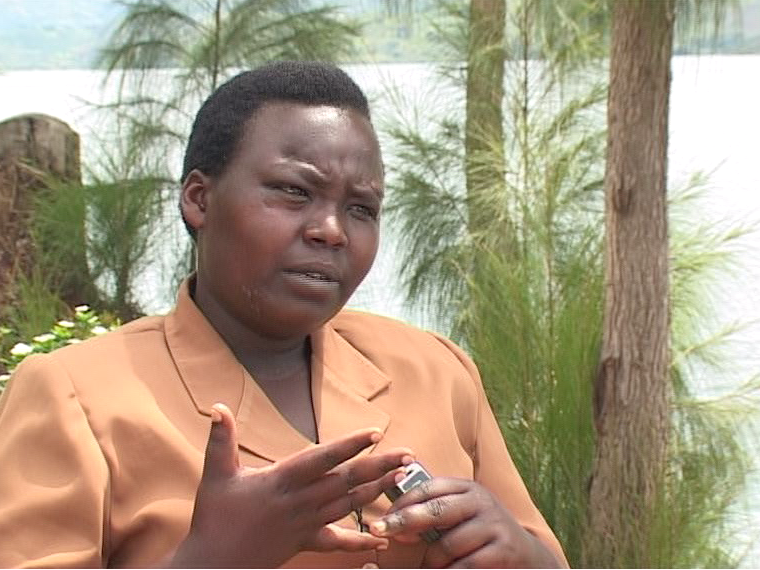
- Esther Uwayisenga (April 21, 2009, Kibuye, at the edge of lake Kivu)
- "It was May 12. (…) I was up on the hill. I couldn't see everything. But personally, I saw four [soldiers] gettin out of a vehicle. (…) There were these white people that I saw, and a Rwandan in civilian clothes. "
-
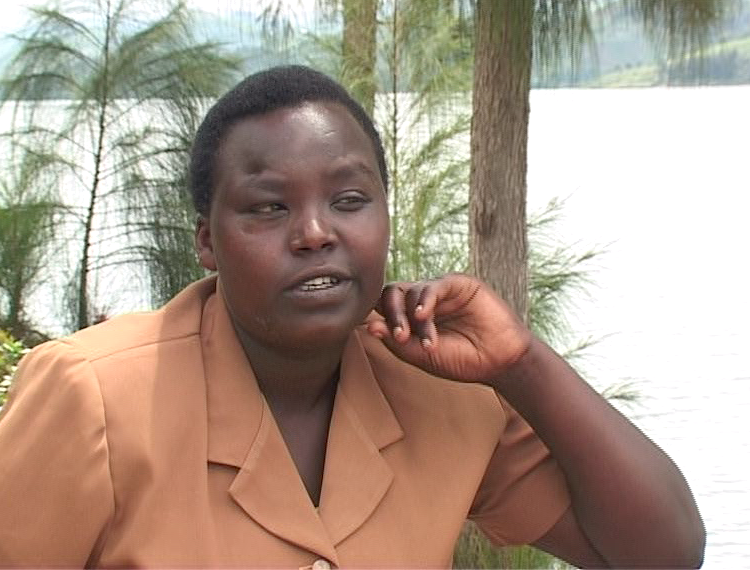
- Esther Uwayisenga (April 21, 2009, Kibuye, at the edge of lake Kivu)
- "It was the next day that I was macheted. (...) May 13. (...) It is a date that I cannot forget. They killed my whole family, and it was that day that I was macheted. "
-
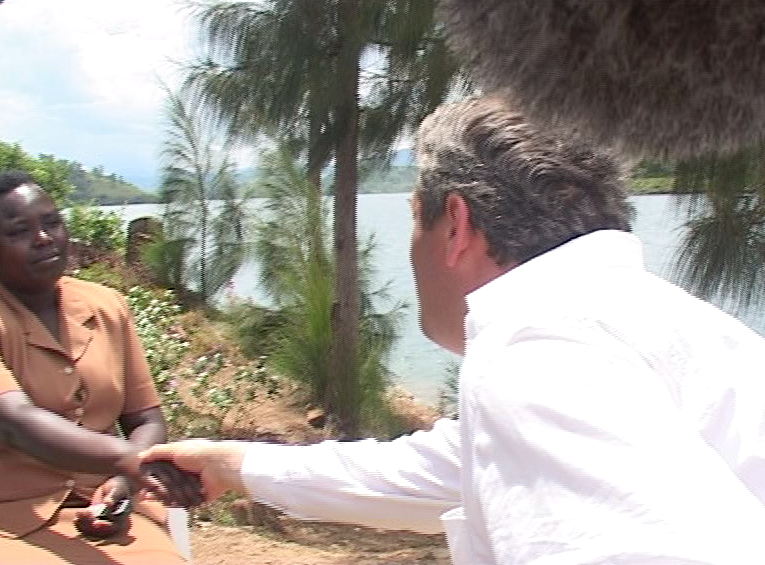
- Esther Uwayisenga (April 21, 2009, Kibuye, at the edge of lake Kivu)
-
 Antoine Sebirondo in a room of Home Saint-Jean in Kibuye, April 21, 2009 :
Antoine Sebirondo in a room of Home Saint-Jean in Kibuye, April 21, 2009 :
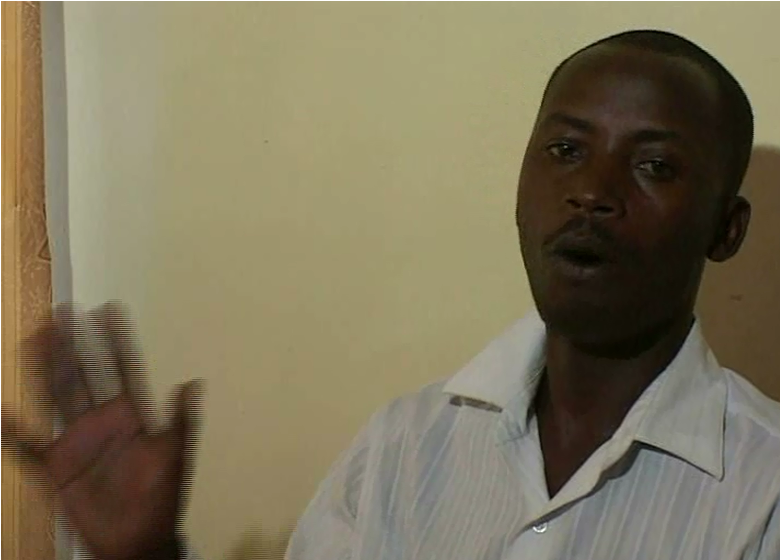
- Antoine Sebirondo (April 21, 2009, in a room of Home Saint-Jean in Kibuye)
- "On May 12, when I was on Nyakigugu hill, I saw vehicles with white people passing by (...) They were military cars with tarpaulins. I saw soldiers in uniform. I could see they were white people. "
-
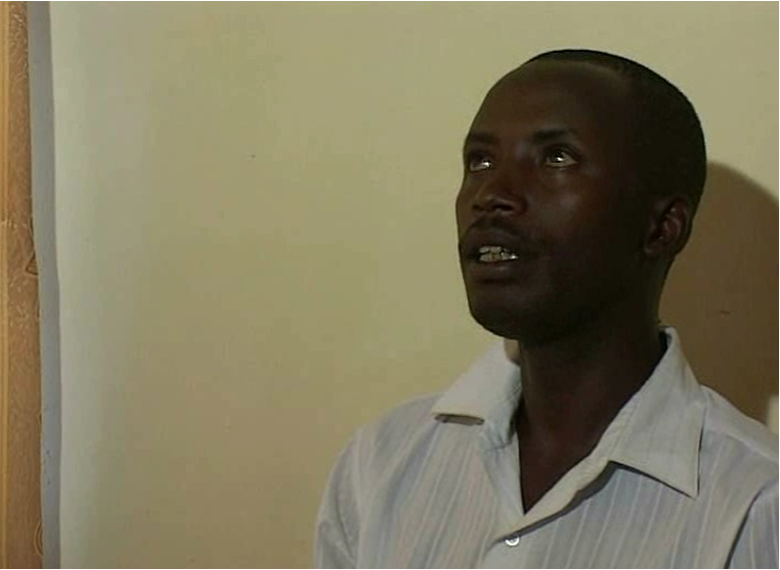
- Antoine Sebirondo (April 21, 2009, in a room of Home Saint-Jean in Kibuye)
- "The vehicles stopped in the stronghold of the Interahamwe militiamen, in the same place where they used to gather. (...) They surrounded the vehicle. They were Interahamwe militiamen."
-
 Adrien Harolimana in a room of Home Saint-Jean in Kibuye, Apri 22,l 2009 :
Adrien Harolimana in a room of Home Saint-Jean in Kibuye, Apri 22,l 2009 :
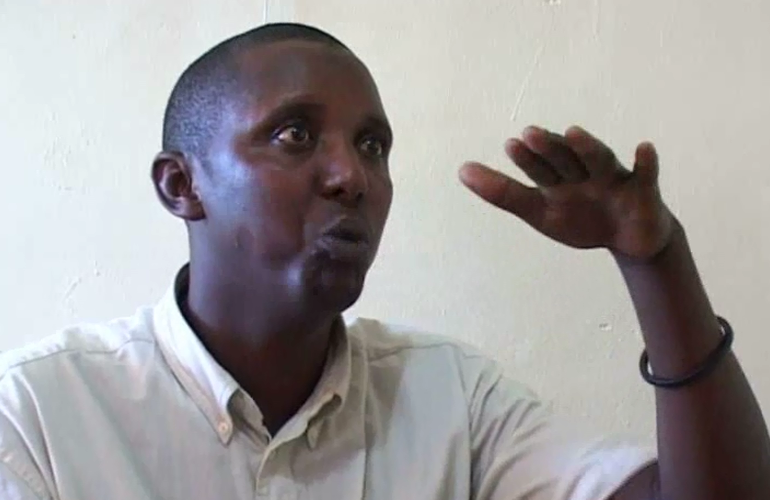
- Adrien Harolimana (April 22, 2009, in room of Home Saint-Jean in Kibuye)
- "I saw them [May 12] after I got on the road. I saw those who were on the right side. They were white."
-
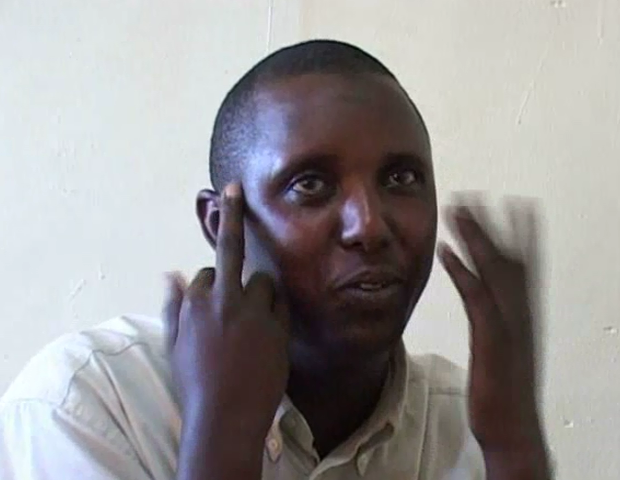
- Adrien Harolimana (April 22, 2009, in room of Home Saint-Jean in Kibuye)
- "In the last vehicle I could see, I saw on the back seat that there were two Whites between whom there was a Black."
-
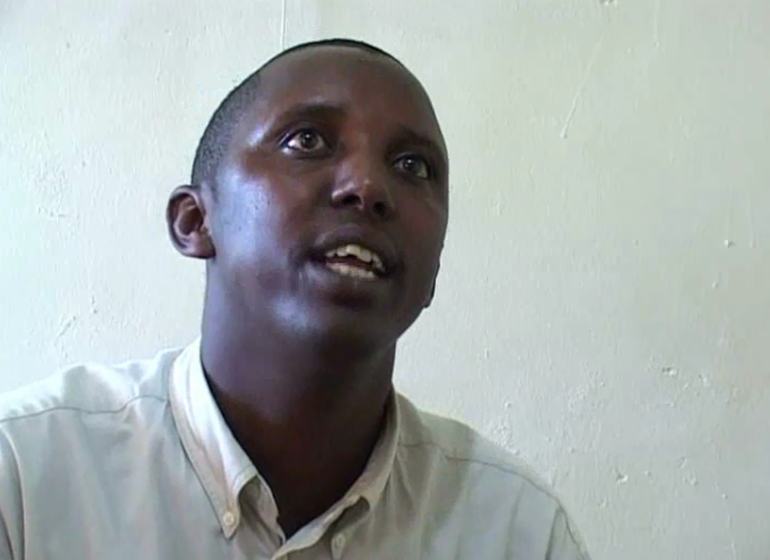
- Adrien Harolimana (April 22, 2009, in room of Home Saint-Jean in Kibuye)
- "I saw two vehicles, just behind. The others had already seen these military vehicles. (...) I heard people say that White people might have come to save us. "
-
 Sylvère Nyakayiro in his shop in Mubuga, April 30, 2009 :
Sylvère Nyakayiro in his shop in Mubuga, April 30, 2009 :
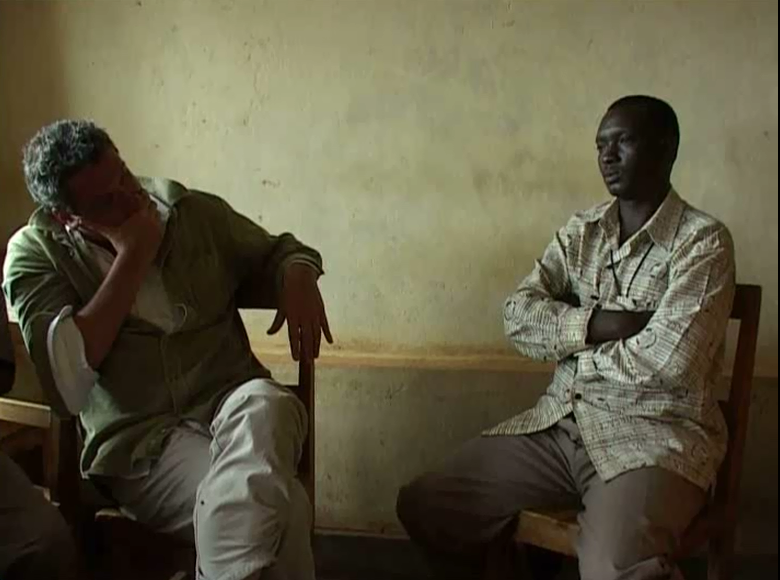
- Sylvère Nyakayiro (April 30, 2009, Mubuga, in his shop)
- "That day [May 13], there were too many people. Everyone was mixed. We met here a white man, there a Rwandan soldier, there a militiaman."
-
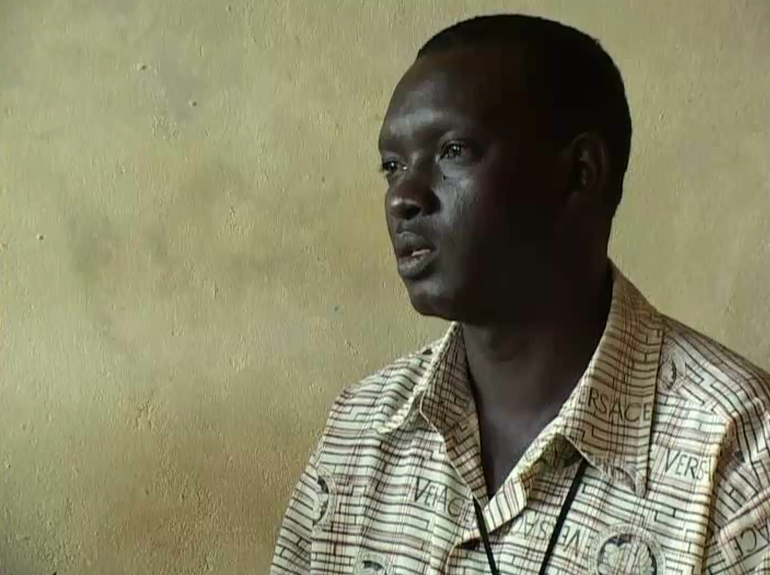
- Sylvère Nyakayiro (April 30, 2009, Mubuga, in his shop)
- "White people were firing on the hills. They were firing. (…) They fired with rockets. They fired with that because they wanted to scare us so that we got out of the woods. Often, it was so powerful that we fell on the spot, and even the trees fell. We ran and obviously the women fell "
-
Selection of photos of individual interviews with former genocidals
Selection of photos of individual interviews with former genocidaires carried out during the first part of the investigation. It is only in a second phase, and following revelations made both during some of these interviews and during individual interviews with survivors, that some reconstitutions will take place on the ground, which will be joined by other witnesses, both survivors and former genocidals.
 Interview dated April 28, 2009 with Fidèle Simugomwa, former chief of the Interahamwe militia in Ruhengeri (northern Rwanda). The interview, which lasts more than three hours, takes place in the multipurpose room of the offices of the former Kibuye prefecture.
Interview dated April 28, 2009 with Fidèle Simugomwa, former chief of the Interahamwe militia in Ruhengeri (northern Rwanda). The interview, which lasts more than three hours, takes place in the multipurpose room of the offices of the former Kibuye prefecture.
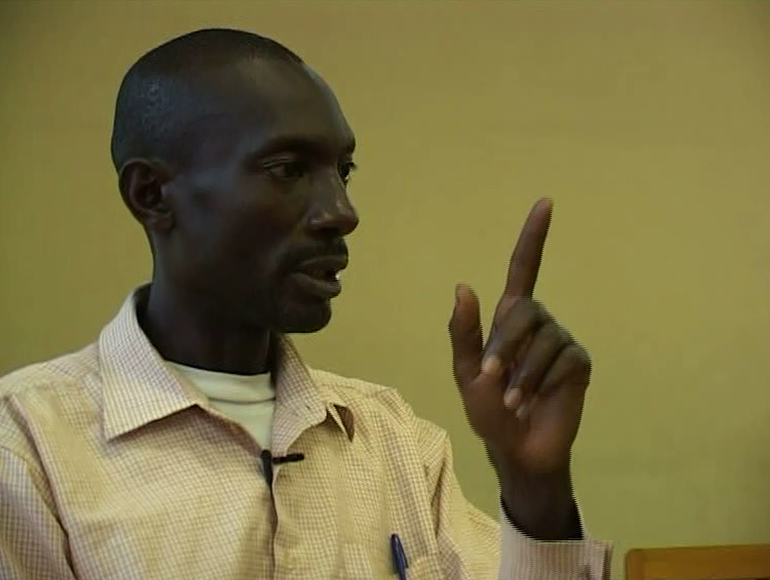
- Fidèle Simugomwa, head of the genocidal militia (multipurpose hall of the offices of the province of Kibuye, April 28, 2009)
-
- "To differentiate the Hutu from the Tutsi, we left [May 13] covered with banana leaves. Because there are a lot of banana trees here."
-
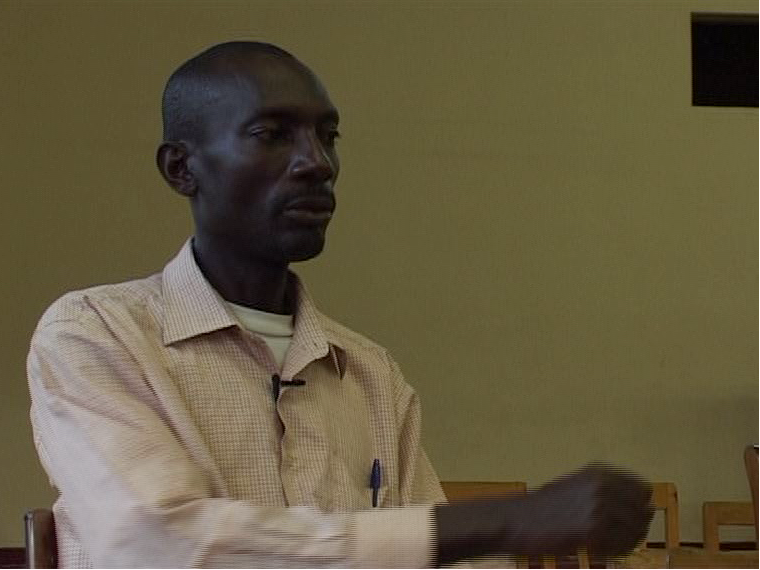
- Fidèle Simugomwa, head of the genocidal militia (multipurpose hall of the offices of the province of Kibuye, April 28, 2009)
- "The French soldiers were shooting at the places where the Tutsi had crowded."
-
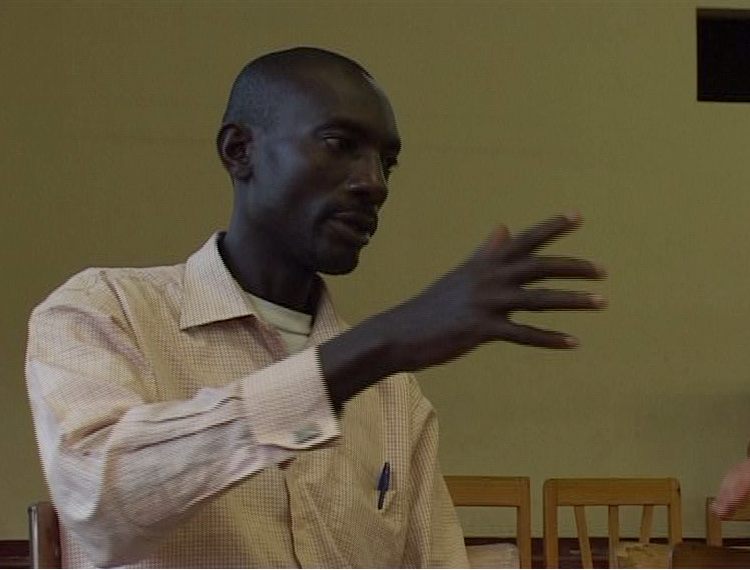
- Fidèle Simugomwa, head of the genocidal militia (multipurpose hall of the offices of the province of Kibuye, April 28, 2009)
- "When the fire stopped, we ran to finish everyone who was still moving."
-
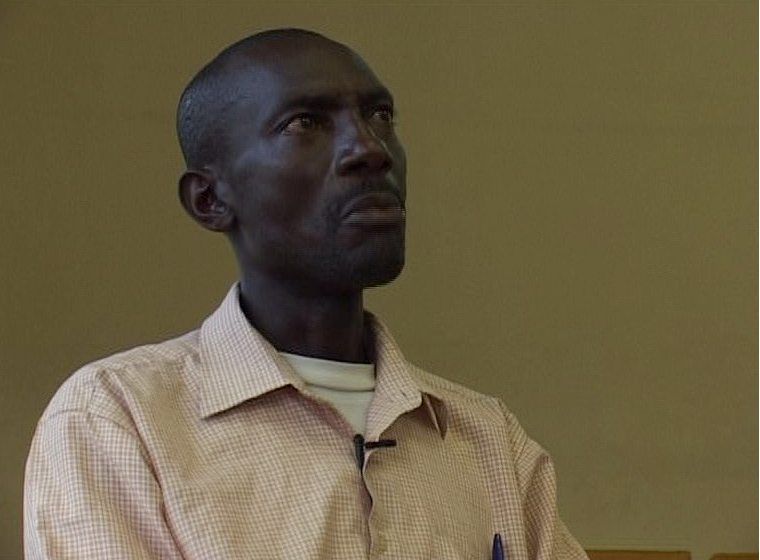
- Fidèle Simugomwa, head of the genocidal militia (multipurpose hall of the offices of the province of Kibuye, April 28, 2009)
- "Oh yes, they were shooting at them ! They were shooting at them. Besides, at that time, there were no Inkotanyi [rebels of the armed wing of the RPF] in Bisesero. Because the Inkotanyi arrived in Bisesero in August. In August, around 19-20. This is when I first saw the Inkotanyi in our commune of Mubuga "
-
 Interview with François Nyamwigema, April 30, 2009.
Interview with François Nyamwigema, April 30, 2009.
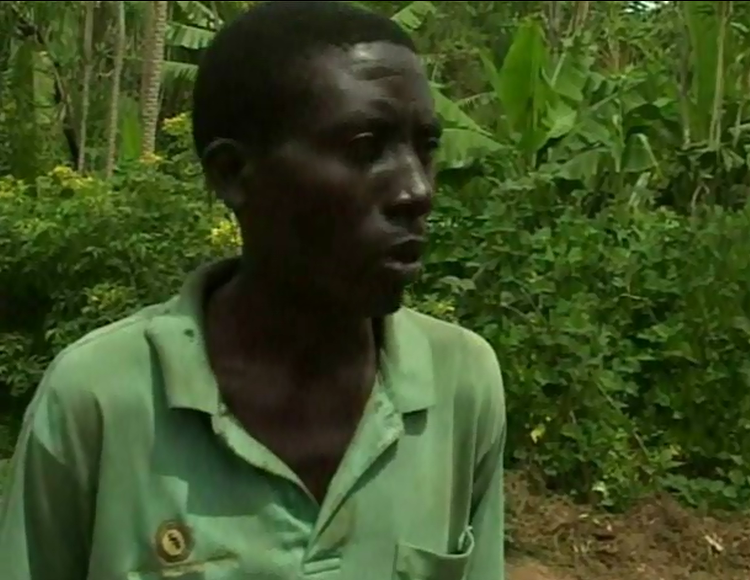
- François Nyamwigema (April 30, 2009)
- "On May 12, we went with the French to Bisesero. They went there in vehicles, while we went there on foot."
-
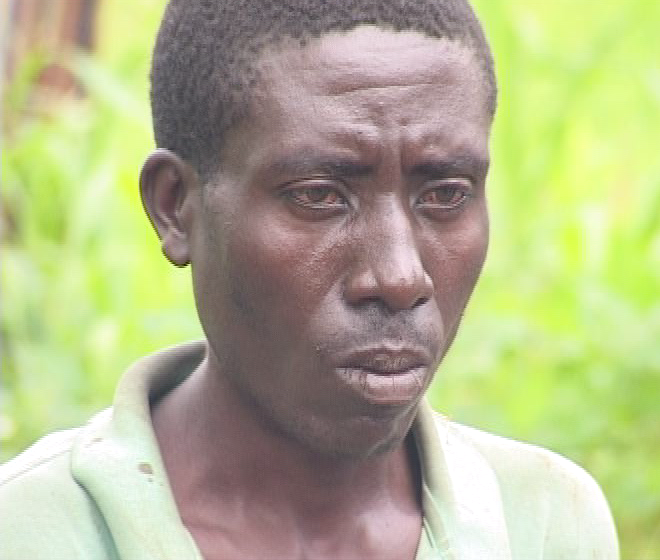
- François Nyamwigema (April 30, 2009)
- "One of the vehicles belonged to the Whites, and another belonged to the bourgmestre."
-
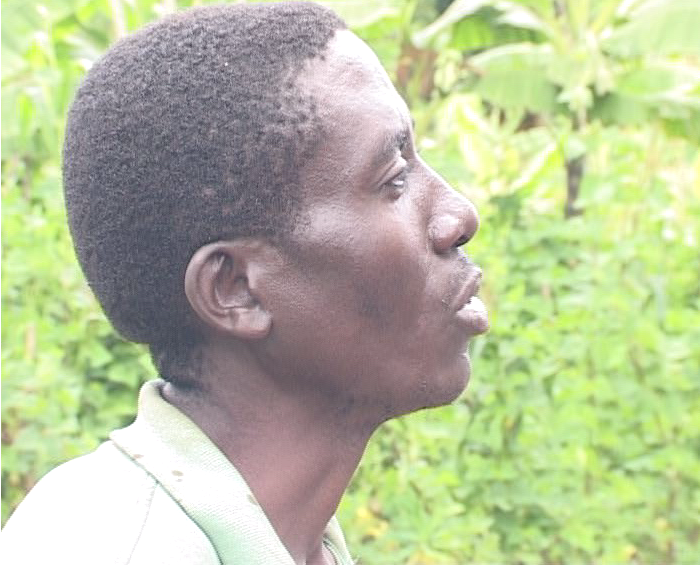
- François Nyamwigema (April 30, 2009)
- "We went in search of the people who were still alive in Bisesero. (…) To assess their number. (…) We walked observing the hills on which we saw them. (…) We didn't count them. We could not. But we were trying to assess their number. "
-
 Interview with Jean Ngarambe in Mubuga, April 30, 2009.
Interview with Jean Ngarambe in Mubuga, April 30, 2009.
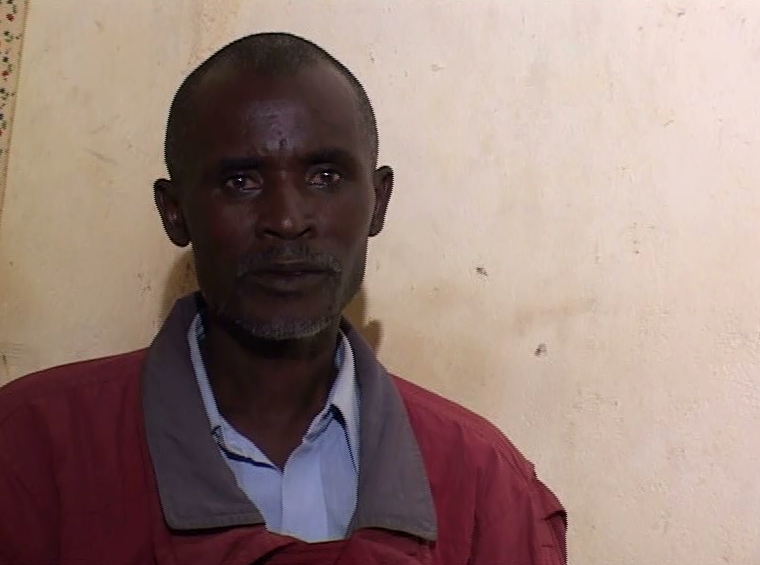
- Jean Ngarambe (Mubuga, April 30, 2009)
- "I did not know that there were French soldiers around here. I only knew that there were Rwandan gendarmes. But when I arrived [on May 12 in Mubuga], I saw French people who were told to have come as reinforcements. "
-
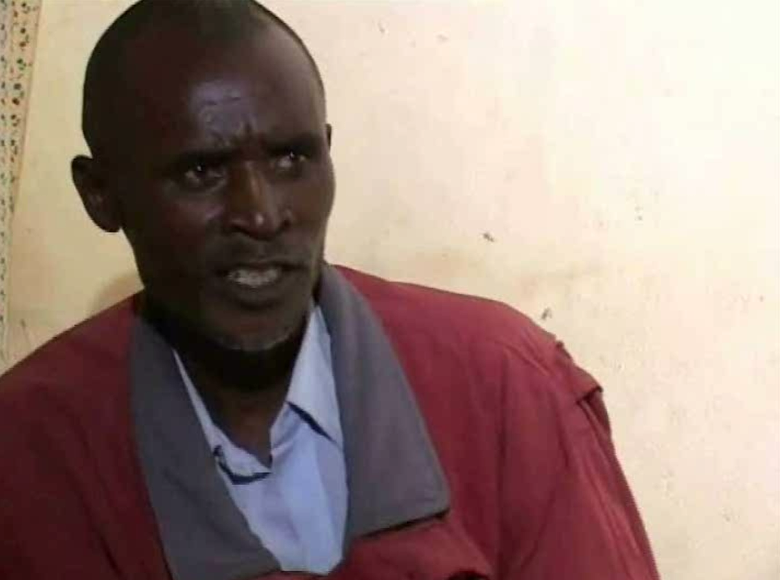
- Jean Ngarambe (Mubuga, April 30, 2009)
- "When we got there [May 13], the assailants began to circulate in the hills and push the Tutsi back to the positions of the Rwandan and French soldiers until they were close enough to them. Then they shoot at them. "
-
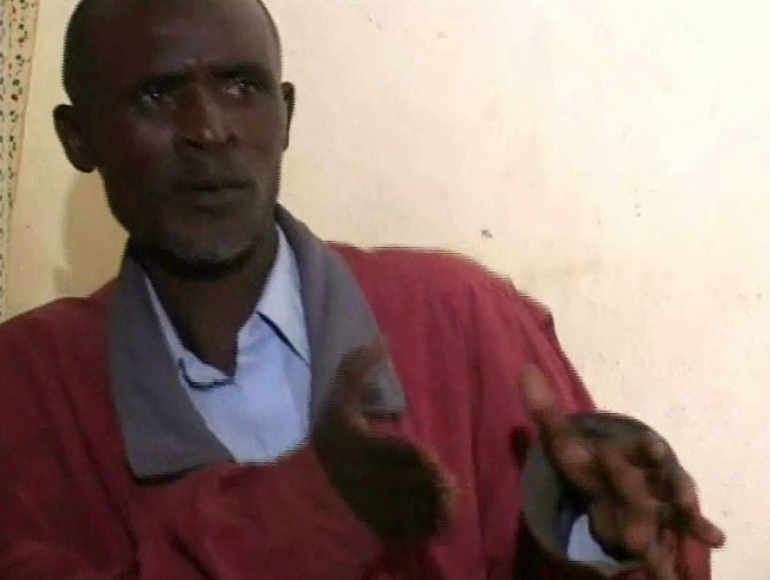
- Jean Ngarambe (Mubuga, April 30, 2009)
- "French and Rwandan soldiers fired, after what the wounded were killed by the militiamen."
-
 Interview with Fidèle Simugomwa in Mubuga, April 30, 2009.
Interview with Fidèle Simugomwa in Mubuga, April 30, 2009.
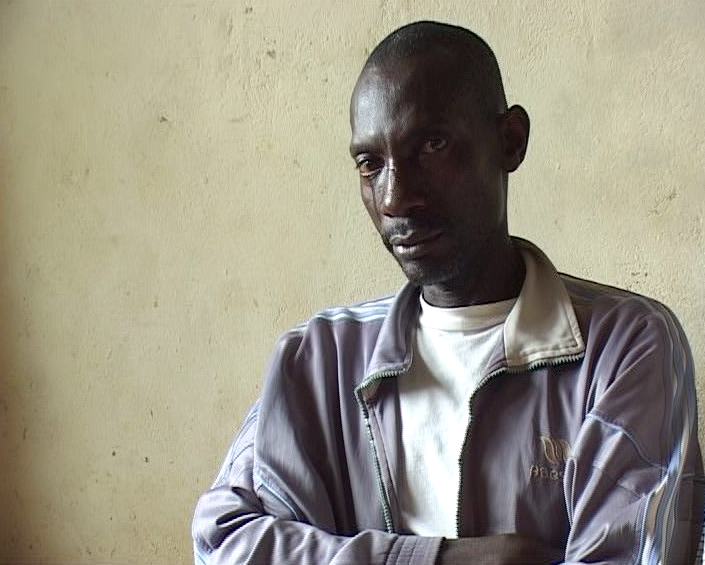
- Fidèle Simugomwa, head of the genocidal militia (Mubuga, April 30, 2009)
- "So far, it has hurt me very deeply. That’s why I cannot hide what happened. "
-
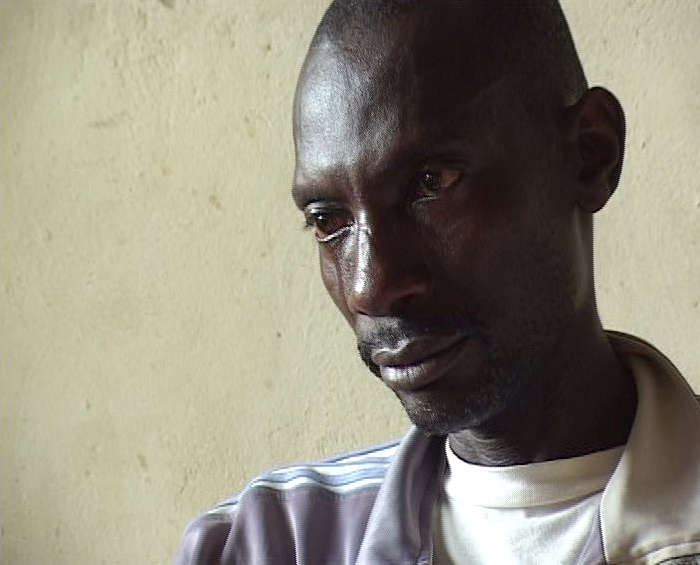
- Fidèle Simugomwa, head of the genocidal militia (Mubuga, April 30, 2009)
- "Even today it still hurts me because among these Tutsi were my best friends."
-
Selection of photos of reconstructions in the field
Selection of photos of reconstructions in the field of scenes previously described in individual interviews. Some reconstructions are individual, others collective.
Visualize the names of the localities and hills mentioned below using the map of the surroundings of Bisesero
MAY 11, 1994: THE PRESENCE OF FRENCH SOLDIERS IN GISHYITA
 Reconstruction dated February 16, 2010 with a former genocidal soldier at the place where the French soldiers had settled since May 11, 1994 (location: Gishyita, CCDFP):
Reconstruction dated February 16, 2010 with a former genocidal soldier at the place where the French soldiers had settled since May 11, 1994 (location: Gishyita, CCDFP):
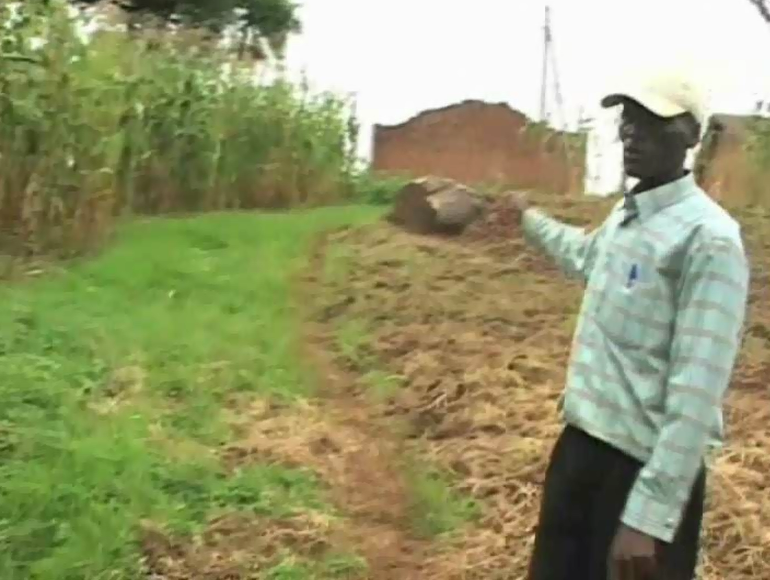
- Semi Bazimaziki (Gishyita, February 16, 2010)
- "They put up tents. I don't know if they entered the houses, because I did not enter them. But there were tents there."
-
MAY 12, 1994: PREPARATION OF THE MASSACRE OF CIVILIANS TUTSI DE BISESERO
 Reconstruction dated April 30, 2009 with a survivor of the morning of May 12, 1994 (location: Gitwa hill, in Bisesero):
Reconstruction dated April 30, 2009 with a survivor of the morning of May 12, 1994 (location: Gitwa hill, in Bisesero):
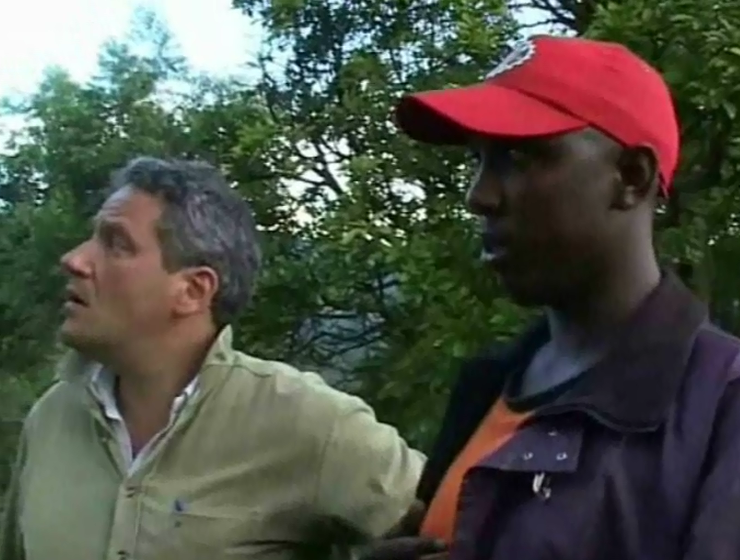
- Adrien Harolimana (Gitwa, April 30, 2009)
- "I was coming here. I was coming up, and I saw them [the white soldiers] when I got here."
-
 Reconstruction dated April 30, 2009 with a survivor of the morning of May 12, 1994 (location: Nyakigugu hill, in Bisesero):
Reconstruction dated April 30, 2009 with a survivor of the morning of May 12, 1994 (location: Nyakigugu hill, in Bisesero):
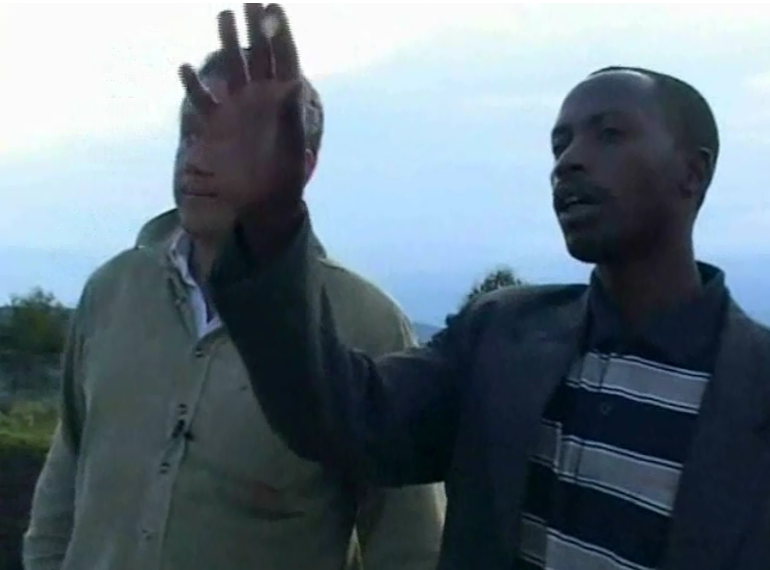
- Antoine Sebirondo (Nyakigugu, April 30, 2009)
- "On May 12, 1994, we were hiding in holes, in this hill there. There are many. These are holes that we dug when we looked for cassiterite in the past. This is where I saw White in vehicles passing by here. (…) They did not stop. They continued. (…) They continued and stopped in Ruhuha "
-
 Testimony collected on the morning of May 12, 1994. Siméon Karamaga was brought by Antoine Sebirondo, who attends the interview. This is not a reconstitution itself, but a testimony taken on February 14, 2010 in Mumubuga. Simeon Karamaga was, during the genocide, the deputy head of the main resistance of Tutsi civilians in Bisesero, which took place on the hill of Muyira
Testimony collected on the morning of May 12, 1994. Siméon Karamaga was brought by Antoine Sebirondo, who attends the interview. This is not a reconstitution itself, but a testimony taken on February 14, 2010 in Mumubuga. Simeon Karamaga was, during the genocide, the deputy head of the main resistance of Tutsi civilians in Bisesero, which took place on the hill of Muyira
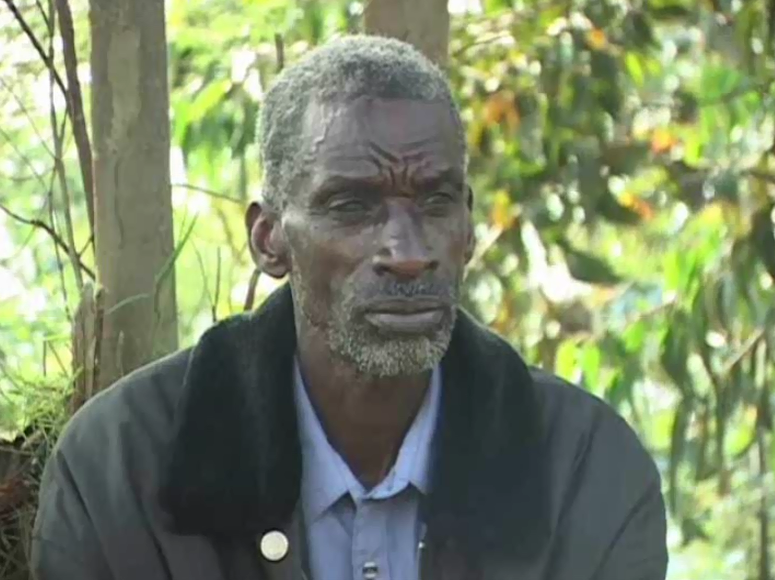
- Simeon Karamaga (February 14, 2010, Mumubuga)
- "When they [the white soldiers] went to Ruhuha, it was in May."
-
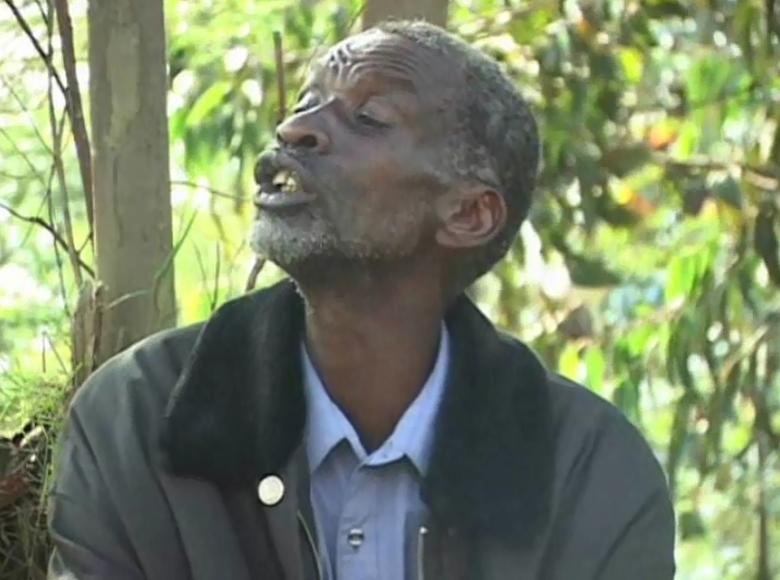
- Simeon Karamaga (February 14, 2010, Mumubuga)
- "That day, they went to Ruhuha, they held a meeting which lasted a very long time. (…) The big meeting was held in Ruhuha, and it was with those who killed us, our assassins. (…) There were a lot of [assassins]. It was like that eucalyptus forest. "
-
 Reconstruction dated February 14, 2010 with former genocidals of the lure intended to deceive Tutsi civilians which took place on May 12, 1994 in Mumubuga (place: Mumubuga, in Bisesero):
Reconstruction dated February 14, 2010 with former genocidals of the lure intended to deceive Tutsi civilians which took place on May 12, 1994 in Mumubuga (place: Mumubuga, in Bisesero):
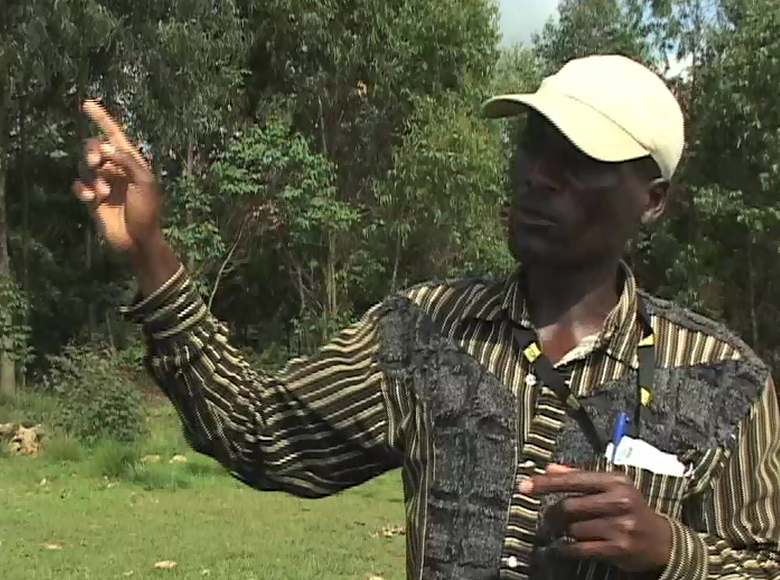
- Semi Bazimaziki (Mumubuga, February 14, 2010)
- "When the Whites arrived here with Sikubwabo [bourgmestre of Gishyita], as soon as they arrived, Sikubwabo showed them the surrounding mountains. He showed them the hills on which the Tutsi were. ..) They [the militiamen], they arrived. They were there behind. And there were Rwandan soldiers, whom I didn't know, who repelled them, who repulsed the militiamen. "
-
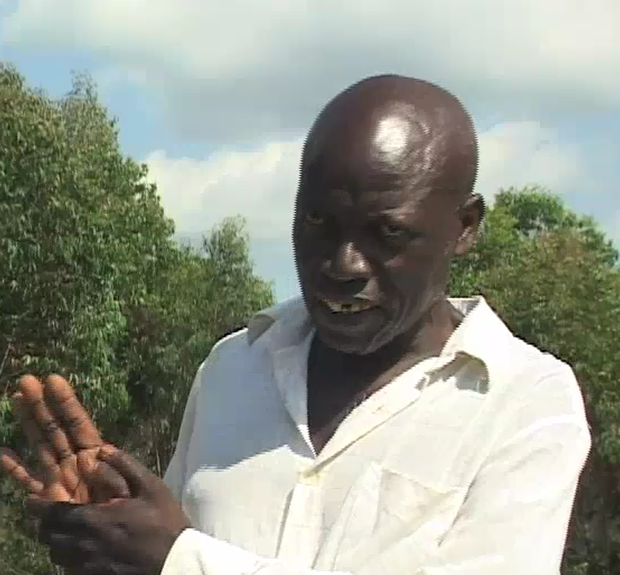
- Raphaël Mageza (Mumubuga, February 14, 2010)
- "Here, they could not say anything, they could not say anything to us, because it was to show the Tutsi, to prove to them that there was no longer any risk, so that all the others who had remained hidden could come later."
-
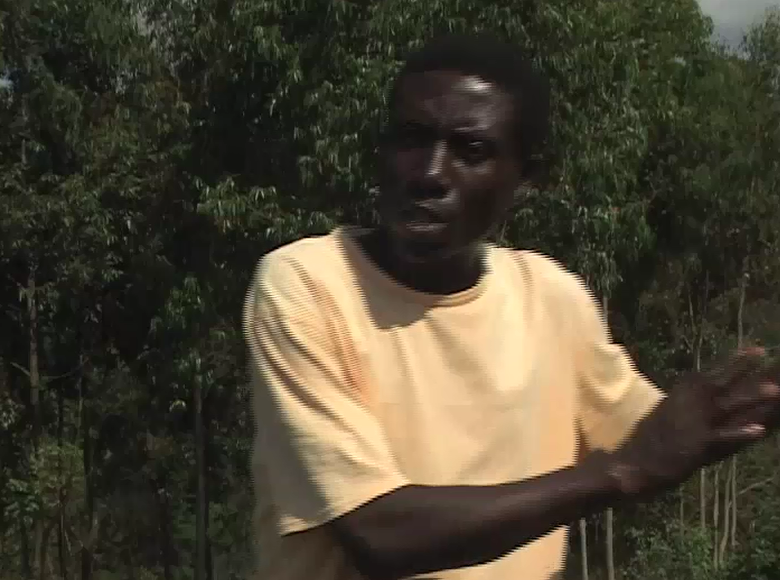
- François Nyamwigema (Mumubuga, February 14, 2010)
- "When we came to settle here, the Tutsi were still there. They were there. And then they said to them," Now you can go back to where you were. We wanted to know if you were still there. Go back to where you were, and tomorrow we will come back with things to assist you, and then to protect you too. ""
-
MAY 13, 1994: THE DEPARTURE OF THE GENOCIDAIRES TO BISESERO
 Reconstitution dated February 15, 2010 with former genocidaires of the popular gathering in the morning of May 13, 1994 in Mubuga Square. Immediately after this gathering, the crowd walked to Bisesero. (place: Mubuga):
Reconstitution dated February 15, 2010 with former genocidaires of the popular gathering in the morning of May 13, 1994 in Mubuga Square. Immediately after this gathering, the crowd walked to Bisesero. (place: Mubuga):
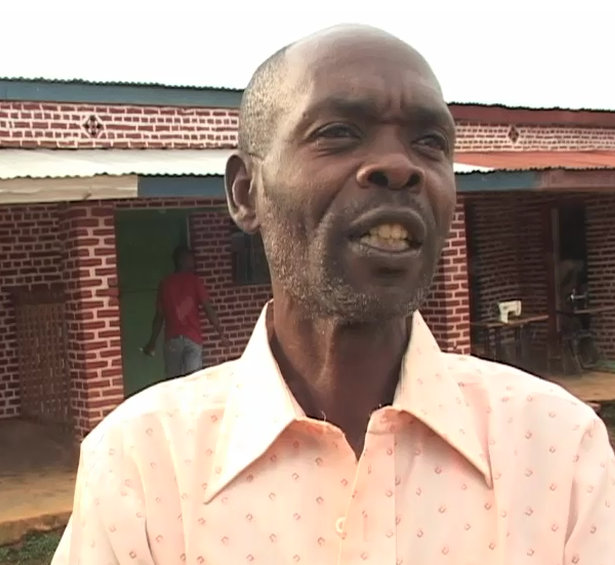
- Hesron Bazimaziki (Mubuga, February 15, 2010)
- "[Sikubwabo] told us [the morning of May 13] that the goal was to eliminate, totally exterminate the Tutsi from Bisesero, and that afterwards, we would settle other people there, only after their extermination, we would implant other people there. "
-
 Reconstruction dated February 16, 2010 with a former genocidal of the departure on May 13, 1994 of the convoy of genocidals from Gishyita to Bisesero (place: Gishyita, in front of the bar of Mikaeli Muhimana, known as Mika):
Reconstruction dated February 16, 2010 with a former genocidal of the departure on May 13, 1994 of the convoy of genocidals from Gishyita to Bisesero (place: Gishyita, in front of the bar of Mikaeli Muhimana, known as Mika):
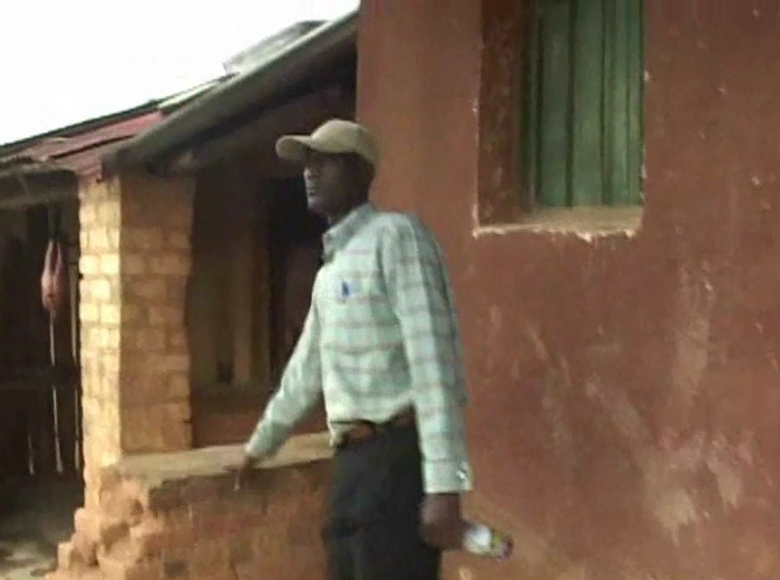
- Semi Bazimaziki (Gishyita, February 16, 2010)
- "They were also sitting here. The first time I saw them here was on the 13th."
-
MAY 13, 1994: THE MASSACRE OF THE TUTSI CIVILIANS OF BISESERO
 Reconstruction dated February 15, 2010 with two former genocidals of the massacre of Tutsi civilians gathered on the hills of Mataba (also called "Sakufe hill"), Kagari and Muyira (place: Uwingabo hill facing these three hills):
Reconstruction dated February 15, 2010 with two former genocidals of the massacre of Tutsi civilians gathered on the hills of Mataba (also called "Sakufe hill"), Kagari and Muyira (place: Uwingabo hill facing these three hills):
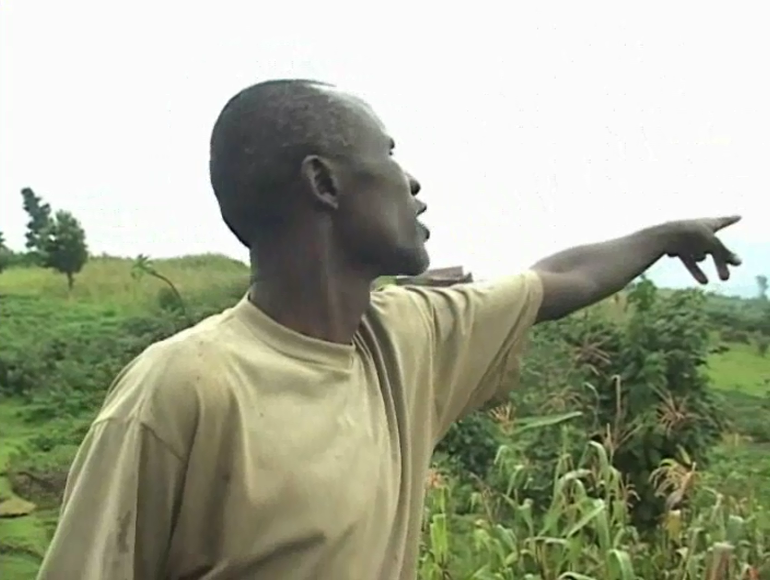
- Jean Ngarambe (Uwingabo, February 15, 2010)
- "Those who came from Gisovu and Gikongoro went to this hill where the Tutsi were, and drove them back to this small hill there (Kagari). Once these Whites, who were with us as well as with the Rwandan soldiers, had them collected and driven back there, they placed rockets on their rifles, and threw them into this direction. (Raphaël Mageza then made the gesture indicating how they were putting these rockets). "
-
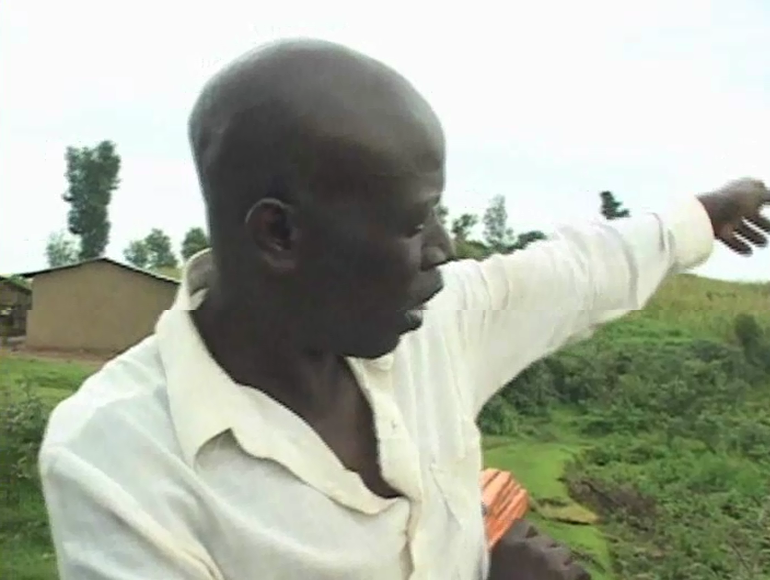
- Raphaël Mageza (Uwingabo, February 15, 2010)
- "Me, I saw others. I saw for example in Nyiramakware. Because from here, when these Tutsi were killed, some escaped us and started to run for example by going down towards over there, because there are forests. So we hunted them. By hunting them, we came to Nyiramakware. There, there were other attacks, and in these attacks, there were also other Whites. "
-
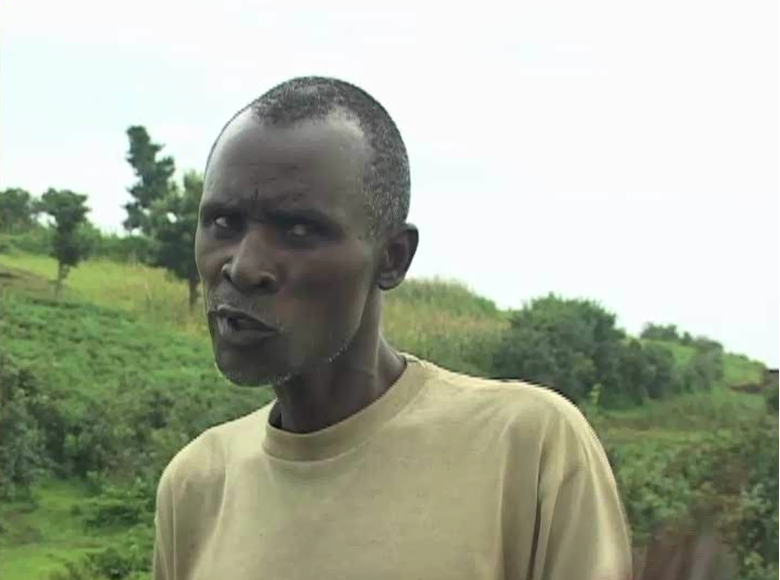
- Jean Ngarambe (Uwingabo, February 15, 2010)
- "When the Tutsi moved to save themselves - what we can understand - we ran after them, and the others also moved. They were not going to stay like that, parking, when their goal was to kill. They weren't there to guard the bodies "
-
-
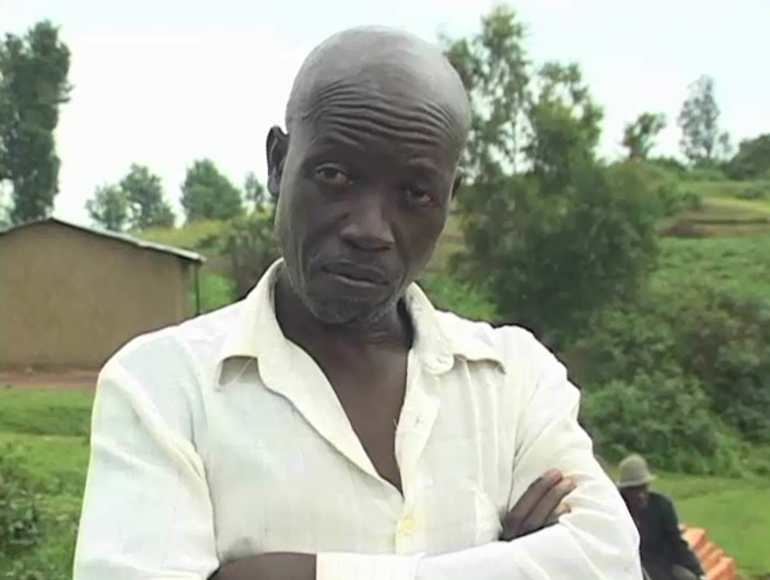
- Raphaël Mageza (Uwingabo, February 15, 2010)
- "Me, in my heart, really, I was not afraid at all. Because these people we were attacking, I realized that they did not have heavy weapons to fight us."
-
 Reconstruction dated February 15, 2010 with survivors of the massacre of Tutsi civilians gathered on the hills of Mataba (also called "Sakufe hill"), Kagari and Muyira (place: Uwingabo hill facing these three hills):
Reconstruction dated February 15, 2010 with survivors of the massacre of Tutsi civilians gathered on the hills of Mataba (also called "Sakufe hill"), Kagari and Muyira (place: Uwingabo hill facing these three hills):
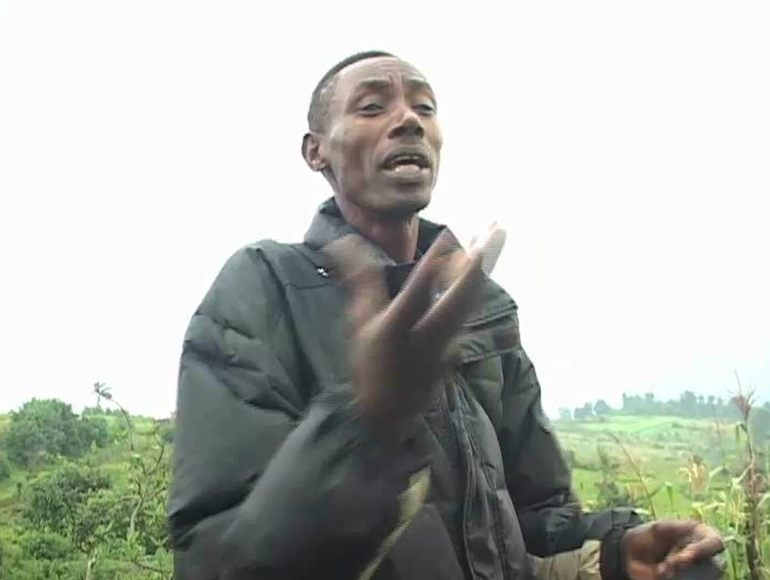
- Emmanuel Karebana (Uwingabo, February 15, 2010)
- "We saw white people. We saw Rwandan Interahamwe. Do you see this road ? It was full of vehicles, buses, trucks, vehicles bringing people from afar, and this road was full. When they came here, they made a kind of chain. There were white people, Rwandans, Interahamwe, soldiers. "
-
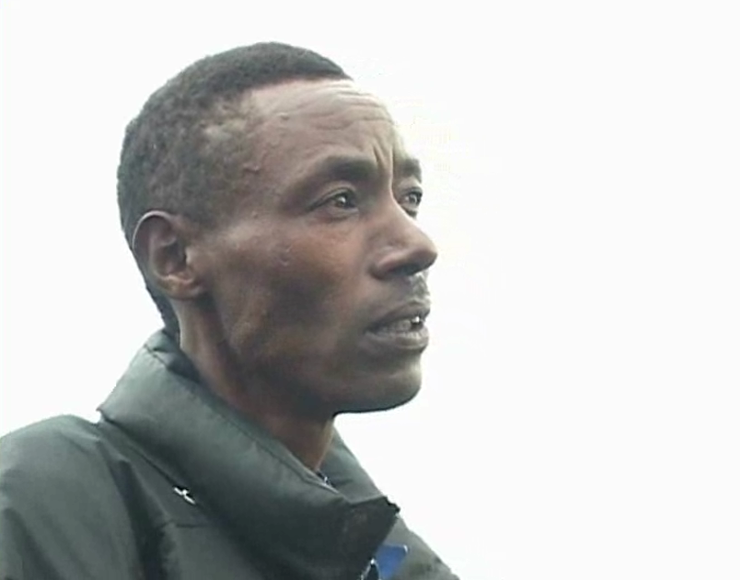
- Emmanuel Karebana (Uwingabo, February 15, 2010)
- "When they sent their rockets, you saw the trees falling, the branches of the trees, which were broken, fell, so it was on this day when the Whites came that I lost the most children."
-
 First testimonies of former genocidals collected on February 15, 2010 of the massacre of Tutsi civilians gathered on the hill of Gititi (place: Mumubuga):
First testimonies of former genocidals collected on February 15, 2010 of the massacre of Tutsi civilians gathered on the hill of Gititi (place: Mumubuga):
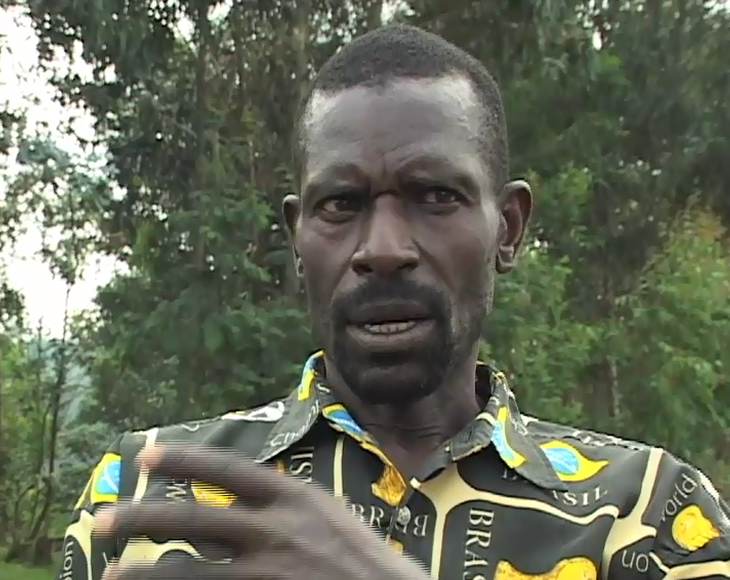
- Elie Ngezenubwo (Mumubuga, February 15, 2010)
- "The Whites were shooting, and we were using machetes and clubs to go after those who weren't dead instantly."
-
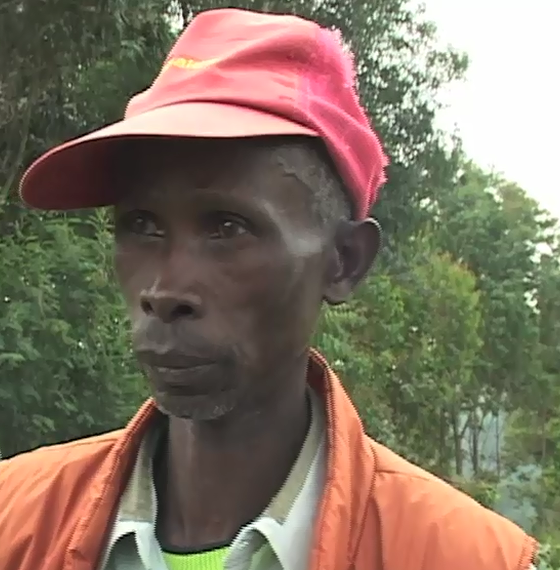
- Faithful Uzabaraho (Mumubuga, February 15, 2010)
- "When we got there, we were shown where to stop. They positioned us. They put us in positions with our weapons, with our instruments. And the Whites coordinated what they had to do with the Rwandan military. "
-
 Reconstruction dated February 15, 2010 with a former genocidal police officer of the massacre of Tutsi civilians gathered on the hill of Gititi (place: hill of Kanyinya facing that of Gititi):
Reconstruction dated February 15, 2010 with a former genocidal police officer of the massacre of Tutsi civilians gathered on the hill of Gititi (place: hill of Kanyinya facing that of Gititi):
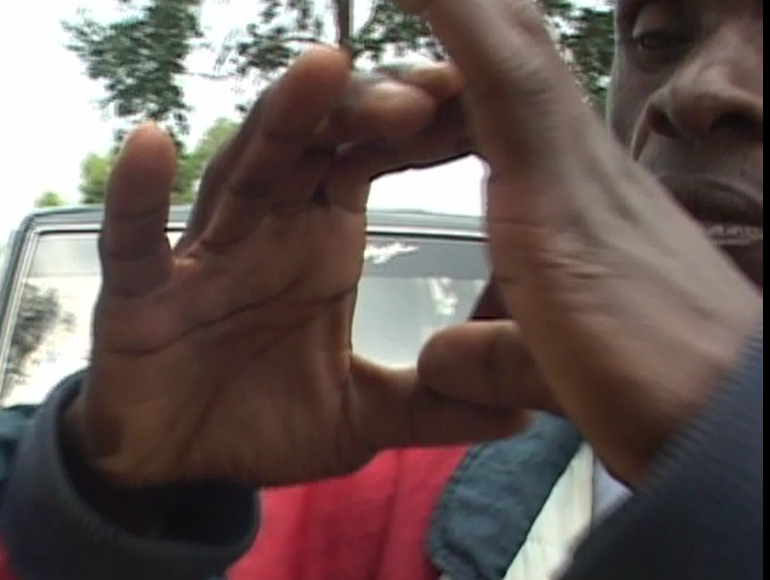
- Sylvestre Rwigimba (Kanyinya, February 15, 2010)
- "It was a great weapon. Even though I was a police officer, I did not know it, and I had never learned to use such a weapon. The barrel was at least the size of this camera lens. The size cannon was like that. "
-
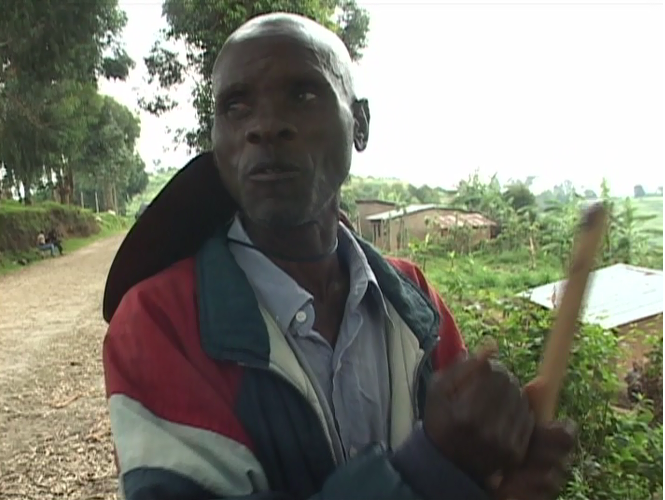
- Sylvestre Rwigimba (Kanyinya, February 15, 2010)
- "Here there were some French people. Others were on the other side of the vehicle. There were also Rwandan soldiers with them. They were mixed with the French. I was stationed here. And there, it made a big noise: "Boo !" Sylvestre now speaks of his weapon: "It was a repeating weapon which could not fire until there. It was too small for that. "
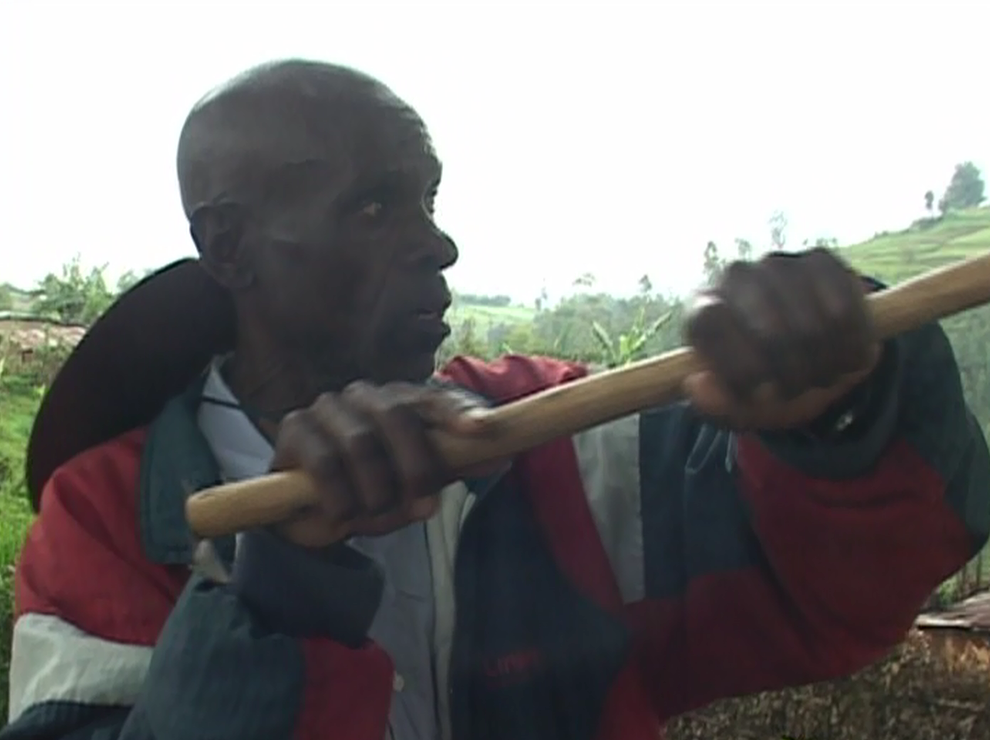
- Sylvestre Rwigimba (Kanyinya, February 15, 2010)
- "It was the Whites. They were the ones who were shooting at a large crowd that was over there on this hill. They were spinning their gun in all directions."
-
 Reconstruction dated February 15, 2010 with survivors of the massacre of Tutsi civilians gathered on Gititi hill (location: Kanyinya hill facing that of Gititi):
Reconstruction dated February 15, 2010 with survivors of the massacre of Tutsi civilians gathered on Gititi hill (location: Kanyinya hill facing that of Gititi):
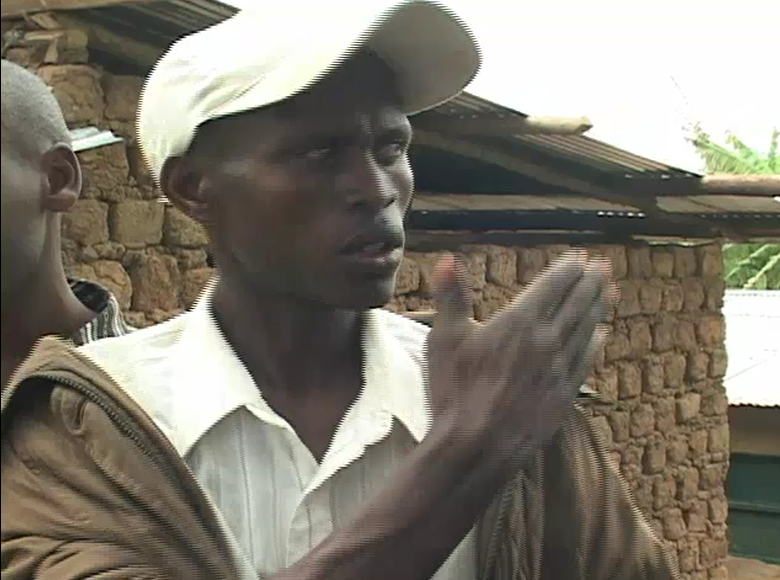
- Casimir Ruzindana (Kanyinya, February 15, 2010)
- "On May 13, 1994, several vehicles got in here. There were quite a few Interahamwe and Whites. They came to this hill. They stopped on this road. We were on the hill opposite, the hill from Gititi. They planted a rifle here, as well as a gun that we did not know, that the Interahamwe did not have. They sent us shells or large caliber bullets. "
-
 Reconstruction dated February 16, 2010 with survivors of the massacre of Tutsi civilians gathered on Nyiramakware hill (place: Mumubuga hill facing that of Nyiramakware):
Reconstruction dated February 16, 2010 with survivors of the massacre of Tutsi civilians gathered on Nyiramakware hill (place: Mumubuga hill facing that of Nyiramakware):
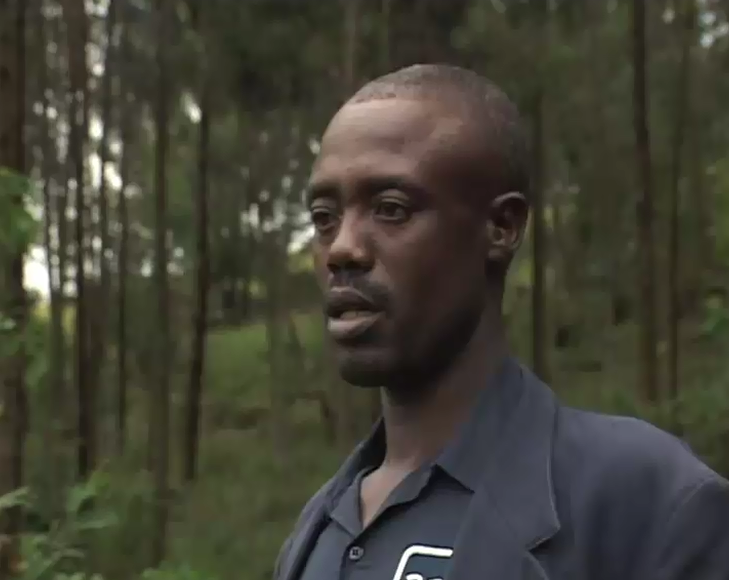
- Martin Nzayisenga (Mumubuga, February 16, 2010)
- "Sikubwabo was dressed in military uniform, as were the Whites who stood between the soldiers."
-
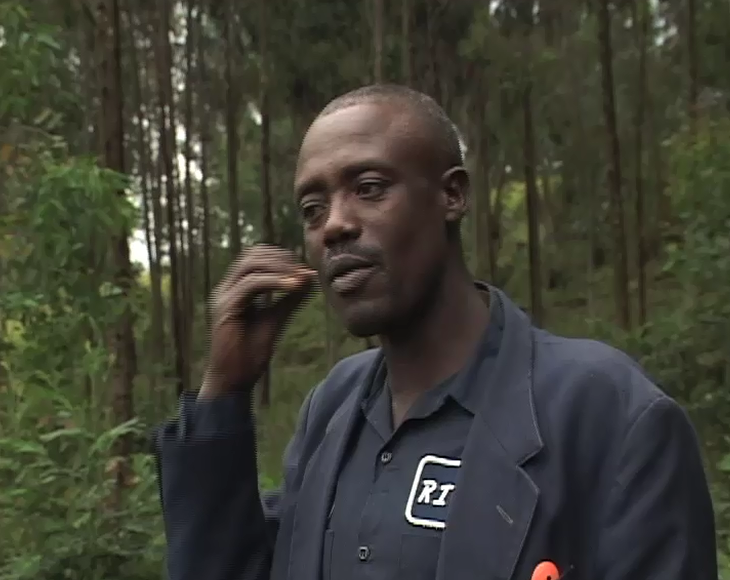
- Martin Nzayisenga (Mumubuga, February 16, 2010)
- "The projectiles they sent out produced a very loud noise at the place where they fell, so that even if we weren't killed, we still felt the hill shaking at the place where we were seated. The arms of the Interahamwe, we hardly feared them any more. "
-
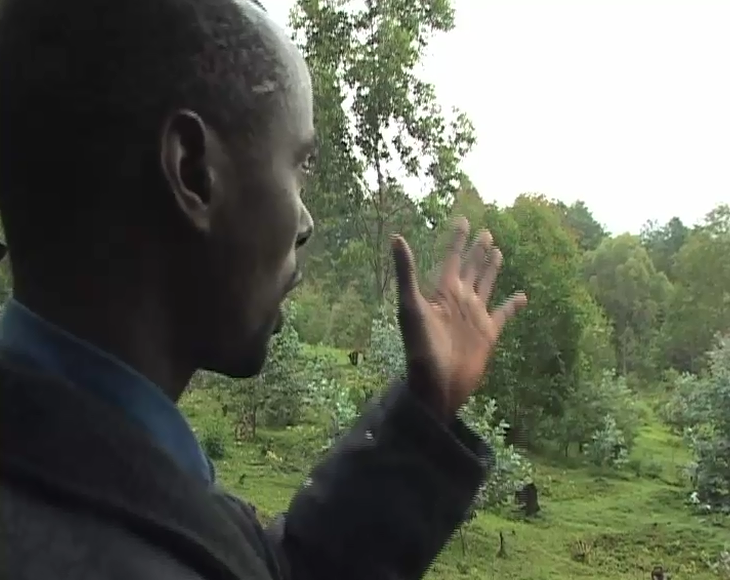
- Vincent Karangwa (Mumubuga, February 16, 2010)
- "There, there was a gallery, a large trench, where a lot of people had hidden. They threw themselves, committed suicide in this trench, in this hole, because there was no longer any refuge. "
-
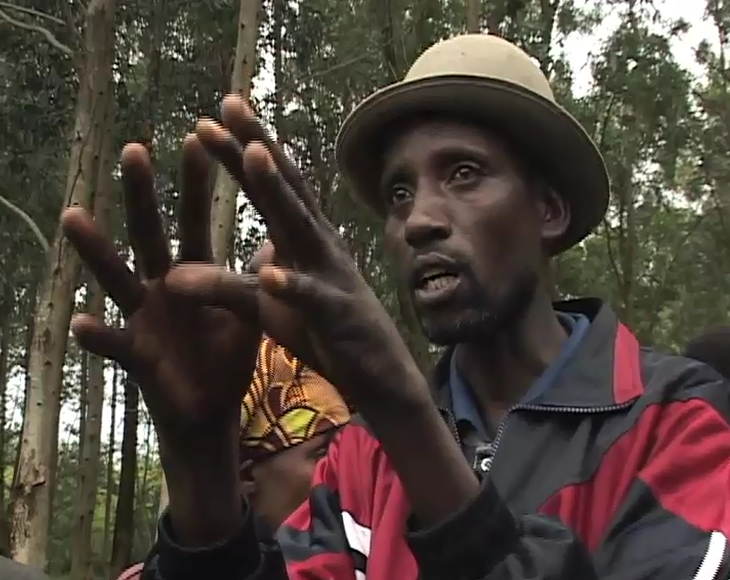
- Faustin Ngarambe (Mumubuga, February 16, 2010)
- "They went down a little lower and continued to shoot. They sometimes approached the bodies to see if the people were dead. As for the Interahamwe, they finished those who were not completely dead."
-
 Reconstruction dated February 16, 2010 with former genocidals of the massacre of Tutsi civilians gathered on Nyiramakware hill. Each of these former genocidals is positioned away from the other witnesses, in one of the places where one of the white soldiers who, on May 13, were targeting the Tutsi located on the hill opposite, Nyiramakware hill. (location: Mumubuga hill facing Nyiramakware hill):
Reconstruction dated February 16, 2010 with former genocidals of the massacre of Tutsi civilians gathered on Nyiramakware hill. Each of these former genocidals is positioned away from the other witnesses, in one of the places where one of the white soldiers who, on May 13, were targeting the Tutsi located on the hill opposite, Nyiramakware hill. (location: Mumubuga hill facing Nyiramakware hill):
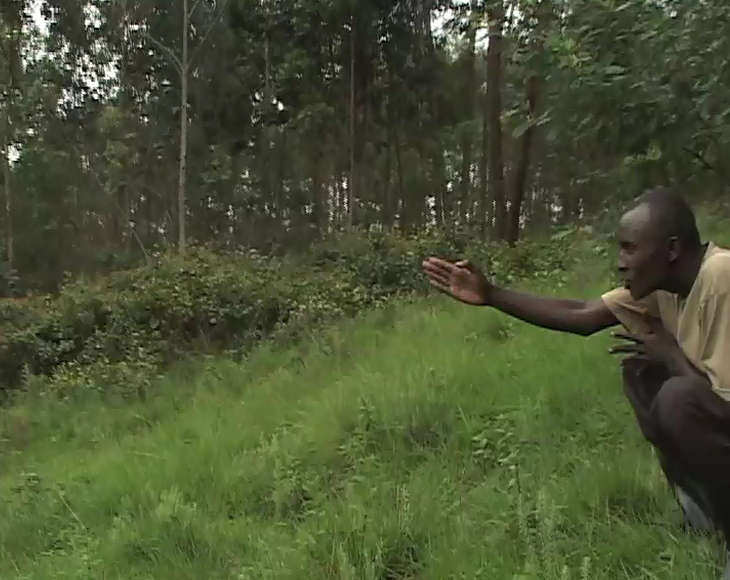
- Jean Ngarambe (Mumubuga, February 16, 2010)
- "The one who was here was aiming at the top of the hill to prevent them from fleeing there, heading north."
-
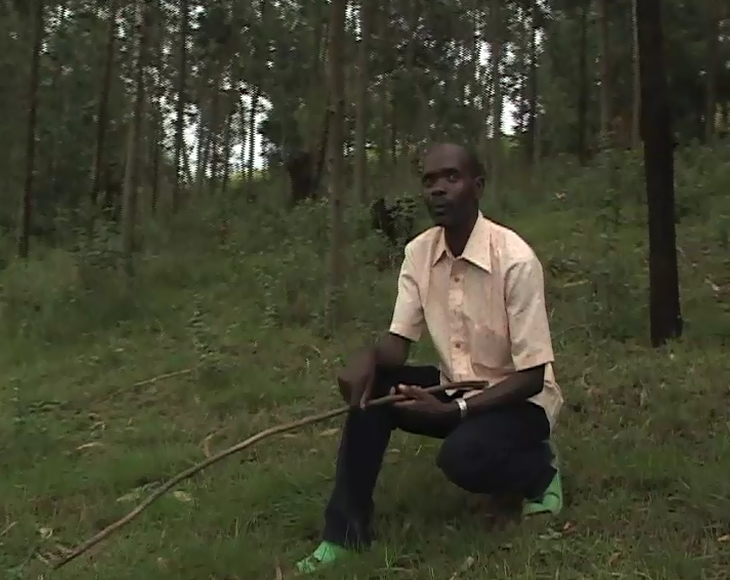
- Hesron Bazimaziki (Mumubuga, February 16, 2010)
-
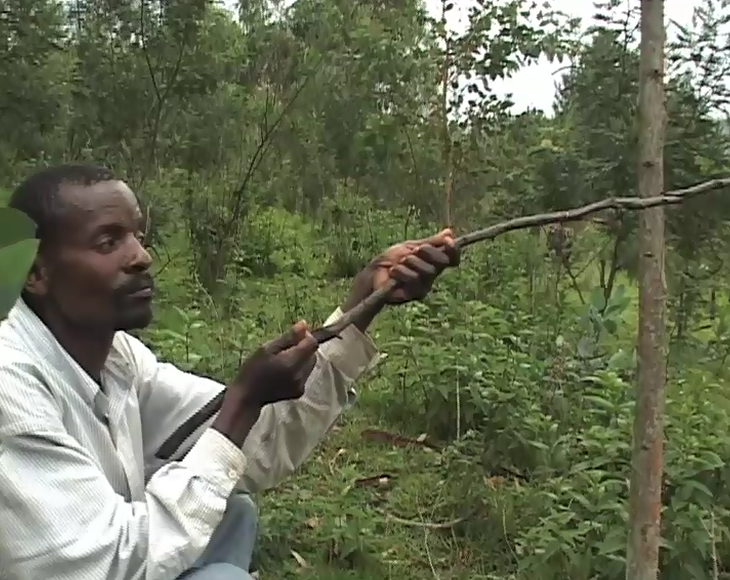
- Uziel Habimana (Mumubuga, February 16, 2010)
- "There were these white soldiers, as well as Interahamwe who came from Bugarama, others who came from Gisenyi. So these soldiers started shooting, after what the one who, stumbling, came out of his hiding place, from the bush, wounded or not, we cut him. "
-
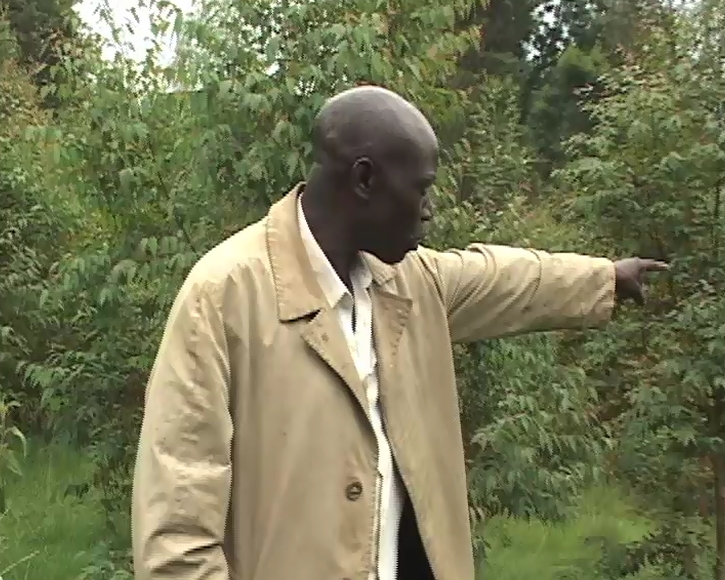
- Raphaël Mageza (Mumubuga, February 16, 2010)
- "When I got here, I found a white man standing there. We were told to go downstairs, and start looking for the dying wounded people who are still there, below, in order to kill them. (…) It was the Interahamwe who had come from Bugarama who told us: "Find the wounded and finish them off." "
-
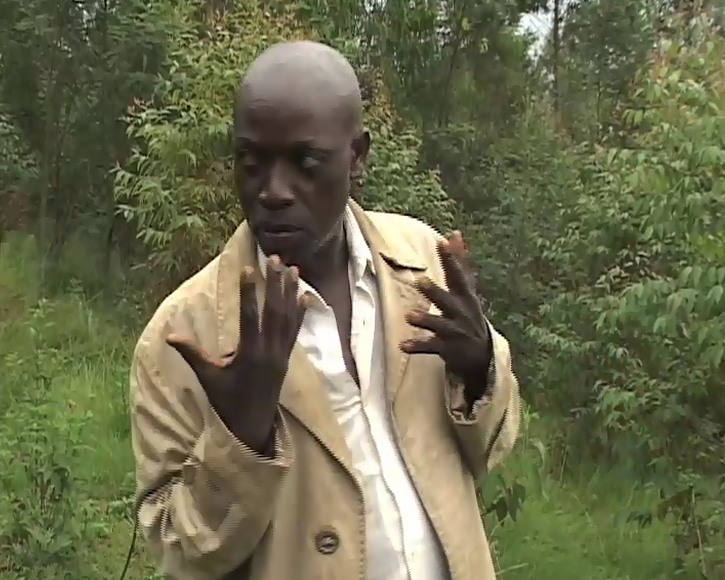
- Raphaël Mageza (Mumubuga, February 16, 2010)
- "The survivors buried themselves in the galleries of which they had blocked the entrance with their dead. We removed these deads who blocked the access of the galleries, and we found, inside, people still alive. We saw them, and we killed them. "
Images of witnesses, of the investigation, of the reconstructions.
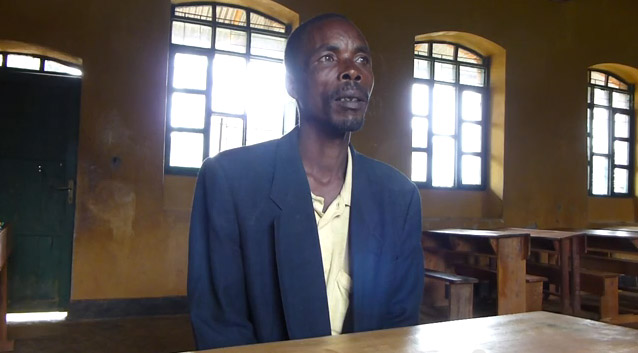
- Bisesero survivor
- B. Mutuyemungu interviewed by Bruno Boudiguet in April 2013
-
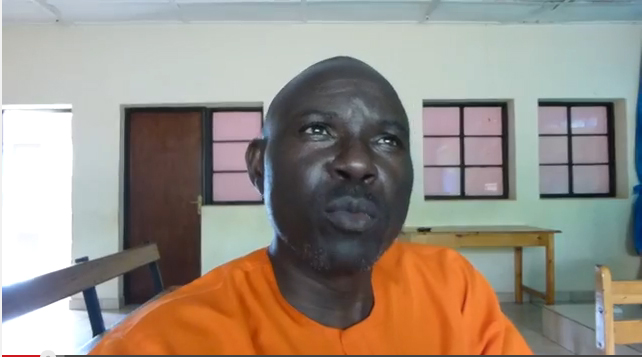
- Interview of a prisoner in Rwanda
- S. Sinzabakwira, interviewed by Bruno Boudiguet on April 30, 2013
-
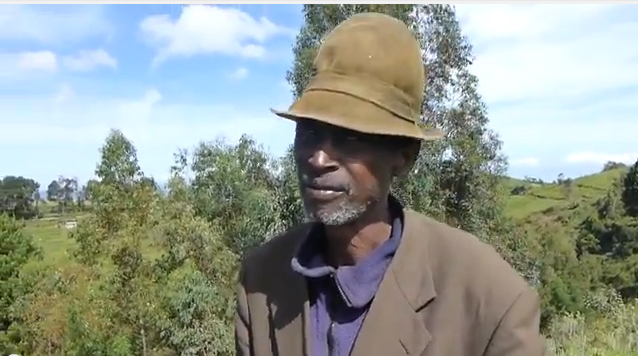
- Survivor of Bisesero
- M. Munyampeta interviewed by Bruno Boudiguet in April 2013
-